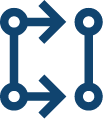Introduction to Infrastructure Security in Cloud Computing
Cloud computing has revolutionized the way businesses operate, providing scalable and flexible solutions for storing, managing, and accessing data and applications. With the increasing adoption of cloud infrastructure, ensuring robust security measures is of paramount importance. Infrastructure security in cloud computing involves protecting the underlying technology stack, including servers, networks, operating systems, and storage systems.
While harnessing cloud infrastructure for IT services offers numerous advantages, including enhanced flexibility, cost efficiency, and improved business continuity, a staggering 96% of organizations have faced substantial obstacles during the execution of their cloud strategies.
This article aims to explore the essential tools required for infrastructure security in cloud computing. We will delve into network security tools, identity, and access management (IAM) solutions, as well as security information and event management (SIEM) tools. By understanding these key components of cloud infrastructure security, businesses can enhance their overall defense against cyber threats.
Network Security Tools for Cloud Infrastructure
Approximately 45% of security breaches have their origins in the cloud. Recent survey findings reveal that a substantial 80% of companies encountered a cloud security incident within the past year, with 27% of organizations grappling with public cloud security incidents—an increase of 10% compared to the previous year.
A. Intrusion Detection Systems (IDS) and Intrusion Prevention Systems (IPS)
Intrusion Detection Systems (IDS) and Intrusion Prevention Systems (IPS) play a crucial role in monitoring network traffic for malicious activities in a cloud environment. IDS passively analyzes network packets to identify potential threats, such as unauthorized access attempts or suspicious traffic patterns. On the other hand, IPS actively blocks or mitigates threats by dropping malicious packets or reconfiguring firewalls.
Key Features and Benefits:
- Real-time threat detection: IDS/IPS continuously monitors network traffic to detect anomalies that may indicate a potential intrusion.
- Automated response: IPS can automatically act against identified threats, preventing them from compromising the network.
- Log generation and analysis: IDS/IPS generates detailed logs for auditing purposes and provides valuable insights into network security events.
Popular IDS/IPS Tools:
- Snort: An open-source IDS/IPS that offers real-time traffic analysis and threat detection capabilities.
- Suricata: A high-performance IDS/IPS solution that provides intrusion detection, network security monitoring, and threat intelligence.
- CloudGen Firewall: Combines traditional firewalling techniques with advanced security features such as IPS, web filtering, and malware protection.
B. Next-Generation Firewalls (NGFW)
Next-Generation Firewalls (NGFW) are designed to address the evolving threat landscape by combining traditional firewall capabilities with advanced features such as application awareness and threat intelligence. NGFWs can identify and control applications traversing the network, allowing organizations to create granular access policies based on user roles, applications, or specific criteria.
Key Features of NGFW:
- Application Visibility and Control: NGFW provides deep packet inspection to identify applications irrespective of port or protocol used.
- Intrusion Prevention System (IPS): NGFWs integrate IPS functionality to detect and prevent known threats from entering the network.
- Threat Intelligence Integration: NGFWs leverage threat intelligence feeds to stay updated on emerging threats.
C. Virtual Private Networks (VPNs)
Virtual Private Networks (VPNs) establish secure connections between remote users or networks and the cloud infrastructure. VPNs use encryption protocols to protect data transmission over public networks, ensuring confidentiality and integrity.
Features of Reliable VPN Solutions:
- Strong Encryption: VPNs employ robust encryption algorithms such as AES (Advanced Encryption Standard) to secure data in transit.
- Multi-Factor Authentication (MFA): VPN solutions incorporate MFA methods like tokens or biometrics to enhance user authentication.
- Scalability and High Availability: VPN solutions should be able to handle many concurrent connections and provide high availability.
Identity and Access Management (IAM) Tools for Cloud Infrastructure Security
A. Single Sign-On (SSO) Solutions
Single Sign-On (SSO) solutions streamline user authentication by allowing users to access multiple applications using a single set of credentials. SSO enhances cloud infrastructure security by centralizing user access control and eliminating the need for multiple passwords or log in credentials.
Benefits of SSO Solutions:
- Improved User Experience: SSO reduces the need for remembering multiple passwords, leading to enhanced productivity.
- Centralized Access Control: SSO enables IT administrators to enforce consistent access policies across multiple applications.
- Integration with Cloud Service Providers: Leading SSO solutions integrate seamlessly with popular cloud service providers and identity providers.
B. Multi-Factor Authentication (MFA) Systems
Multi-factor authentication (MFA) adds an extra layer of security by requiring users to provide multiple forms of identification before accessing cloud resources. MFA systems typically combine two or more factors, such as passwords, biometrics, tokens, or push notifications, for enhanced security.
Authentication Factors used in MFA Systems:
- Something you know: Passwords or PINs.
- Something you have: Physical tokens or mobile devices with authenticator apps.
- Something you are: Biometric characteristics like fingerprints or facial recognition.
C. Privileged Access Management (PAM) Solutions
Privileged Access Management (PAM) solutions focus on securing privileged accounts that have elevated access to critical systems and data within the cloud infrastructure. PAM solutions enforce strict controls around privileged account usage, ensuring accountability and reducing the risk of unauthorized access.
Features of PAM Solutions:
- Session Monitoring: PAM tools monitor privileged user sessions to detect and respond to suspicious or malicious activities.
- Privilege Elevation: PAM enables controlled elevation of privileges for authorized users when necessary.
- Just-In-Time Access: PAM solutions provide temporary access to privileged accounts based on specific timeframes or operational requirements.
Leading PAM Tools:
- Embee Privileged Access Security: Offers comprehensive PAM capabilities, including session monitoring, credential management, and threat analytics.
- Embee Privilege Management for Windows & Mac: Provides secure access control and privilege elevation for both Windows and MacOS environments.
Security Information and Event Management (SIEM) Tools for Cloud Infrastructure
A. Role of SIEM Tools
Security Information and Event Management (SIEM) tools collect, analyze, and correlate logs and security events from various sources within the cloud infrastructure. By centralizing event data, SIEM solutions enable real-time threat detection and incident response.
Features of SIEM Solutions:
- Log Collection and Analysis: SIEM tools ingest logs from various sources such as firewalls, servers, and cloud platforms for comprehensive analysis.
- Real-time Threat Detection: SIEM utilizes correlation rules and machine learning algorithms to identify patterns indicative of potential threats.
- Incident Response Automation: SIEM solutions automate incident response processes, enabling faster detection and mitigation of security incidents.
Conclusion
Infrastructure security in cloud computing is a critical aspect of maintaining the integrity and confidentiality of data and applications. By implementing the right tools and strategies, organizations can strengthen their defense against cyber threats.
In this article, we explored network security tools such as IDS/IPS and NGFWs that monitor and protect network traffic. We also discussed IAM tools like SSO solutions, MFA systems, and PAM solutions that manage user access to cloud resources. Furthermore, we highlighted SIEM tools that collect and analyze logs for real-time threat detection.
To ensure robust infrastructure security in cloud computing, it is essential to combine these tools with other best practices, such as regular updates, vulnerability assessments, and employee training.
At Embee, we understand the importance of comprehensive cloud infrastructure security. Our managed services cover all aspects of infrastructure security, providing businesses with peace of mind in an ever-evolving threat landscape. To learn more about our expertise in cloud infrastructure security solutions, visit our website today.
















































